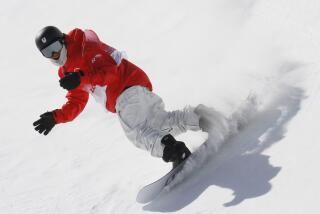Avoiding the Cold Shoulder
- Share via
Staying warm while skiing, camping, mountain climbing or participating in other cold-weather activities isn’t just a matter of comfort--it can reduce the risk of painful frostbite and life-threatening hypothermia.
To minimize these medical dangers, outdoor enthusiasts should learn the warning signs of cold-related problems, acquire basic first-aid and survival skills and dress appropriately, especially if their destination is the winter wilderness.
Even carefully prepared travelers can encounter extreme weather conditions, making it important to recognize symptoms of frostbite, tissue damage due to extreme cold, and hypothermia, an abnormally low body temperature.
A painful sensation is usually the first indication of frostbite. Then feeling is lost. “The most susceptible parts are fingers, toes, nose, ears and the penis,” said Dr. Ken Zafren, an Anchorage emergency physician experienced in wilderness survival techniques.
In particular, frostbite on the nose often escapes self-detection, said Zafren, who encourages outdoor enthusiasts to keep an eye on other members of their group. “If the nose starts to look white at the end,” frostbite should be suspected, he said.
Rewarming the affected body part immediately is advised. “Stick your fingers in your armpits,” Zafren said. “Put your feet on your friends’ stomach, under his clothes.” Drink hot tea and immerse affected body parts in water slightly warmer than body temperature, he said.
Do not rub the area with snow, an often-recommended treatment, because it can cause more tissue damage, Zafren said. Do not hold affected body parts in front of hot air dryers. The skin, because it has lost feeling, could burn easily.
Frostbite is more common in conditions of low temperature and high wind, Zafren said, although contact frostbite “can occur within seconds if you touch something really cold (with bare hands).”
Frostbite can be “a very nasty injury,” said Zafren, who urges immediate medical attention if frostbite is suspected.
Should it prove severe, it is a good idea to request a telephone consultation with a physician at a hospital that includes a thermal unit, Zafren said. (Providence Hospital in Anchorage is one facility that maintains such a unit.)
Another cold-related problem, hypothermia, can be fatal. The declining body temperature can affect the heart, brain and muscular functioning.
“Hypothermia can start subtly,” said Dr. Warren D. Bowman, an internist and hematologist in Billings, Mont., and president of the Wilderness Medical Society, an organization of physicians and others interested in outdoor medicine. Often a person will start to stumble and fumble as the lowered body temperature begins to affect intellectual functioning. “Watch your friend,” Bowman advised, noting that it is difficult to recognize hypothermia in oneself. “If friends start saying something stupid, or mumbling, it’s time to get them to shelter.” In milder stages, generally defined as a body temperature above 90 degrees, hypothermia can be accompanied by skin numbness and chill. A person may have difficulty performing fine motor movements. Then incoordination, weakness and confusion can set in.
When hypothermia becomes more severe, generally defined as a body temperature below 90 degrees, shivering may stop. A person may be unable to walk or stand, or become unconscious.
Warming the body immediately is advised and obtaining professional medical attention quickly is vital.
Learning basic survival skills is a good idea before traveling to the winter wilderness, Bowman said. Knowing how to assemble a shelter and light a fire are among skills that could be useful.
Avoid alcohol and drug use during winter sports, Zafren said. Alcohol can impart a false sense of warmth, he said, and drugs can impair judgment, which can be essential for surviving emergencies in cold climates.
For cold weather, a four-layer dressing plan is recommended, Bowman said.
The first layer should be long underwear made of 100% wool, or a blend of 85% wool and 15% nylon, said Bowman, who acknowledged that this may be difficult to achieve. Also acceptable, he said, are materials such as Thermax, polypropylene and blends of these materials that can wick away moisture from the skin. Avoid cotton and cotton blends for the first layer. For socks, Bowman recommends a pair made of polypropylene next to the skin and then one or two pairs of heavy wool socks on top.
The second layer should include a shirt made of wool, polypropylene or similar materials, a neck warmer (a tube of fabric that covers the neck and can be stretched up to cover the face or head), wool pants, a ski hat or stocking cap and glove liners. Boots to fit the activity--such as mountaineering boots or ski boots--are recommended.
The third layer should include a water-resistant, windproof parka of Gore-Tex or similar material worn over a pile jacket, wind pants (of Gore-Tex or other similar material) and mittens or gloves, Bowman said.
A fourth layer should be easily available in the backpack or gear pack, he recommends. Include a vest or jacket filled with down or synthetic material and a pair of pile or quilted pants. Travelers should also pack rain gear, if that type of weather is a possibility.
The Healthy Traveler appears the second and fourth week of every month.
More to Read
Sign up for The Wild
We’ll help you find the best places to hike, bike and run, as well as the perfect silent spots for meditation and yoga.
You may occasionally receive promotional content from the Los Angeles Times.






